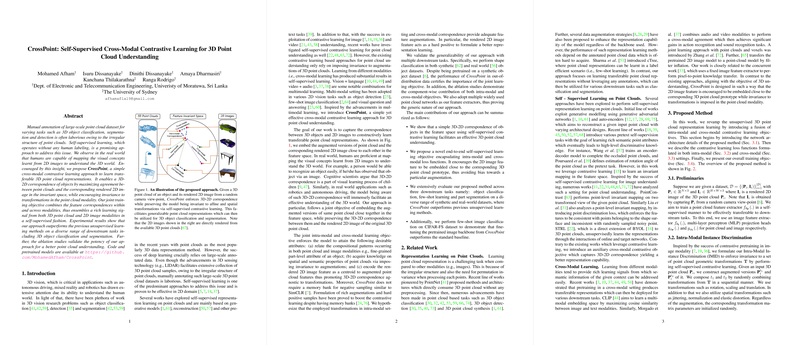Overview of "CrossPoint: Self-Supervised Cross-Modal Contrastive Learning for 3D Point Cloud Understanding"
The paper "CrossPoint: Self-Supervised Cross-Modal Contrastive Learning for 3D Point Cloud Understanding" presents a novel framework, CrossPoint, designed to enhance 3D point cloud representations through a self-supervised learning approach. The core motivation behind this paper stems from the labor-intensive nature of manually annotating large-scale point cloud datasets, necessary for diverse 3D vision tasks such as object classification, segmentation, and detection. Inspired by the human capability to map 2D visual concepts onto the 3D world, the researchers leverage a cross-modal contrastive learning strategy to bridge 3D point clouds and 2D images.
Methodology
The proposed CrossPoint framework employs a self-supervised contrastive learning paradigm to learn effective point cloud representations by establishing both intra-modal and cross-modal correspondences. The intra-modal instance discrimination (IMID) encourages invariance to transformations applied to the point clouds, while the cross-modal instance discrimination (CMID) utilizes relationships between 3D point clouds and their 2D counterparts. The dual nature of this approach ensures that the model benefits from the rich learning signals available in both the 3D and 2D modalities.
Intra-Modal Learning Objective
The intra-modal component focuses on enforcing consistent feature representations for different augmentations of the same 3D point cloud, leveraging transformations such as rotation, scaling, and jittering. By employing contrastive loss, CrossPoint maximizes agreement between differently augmented instances, thus encouraging the model to discern distinctive object attributes within a modality.
Cross-Modal Learning Objective
The cross-modal component involves aligning features between the point cloud modality and the corresponding 2D image modality. This cross-modal correspondence not only anchors the understanding from 2D projections but also introduces hard positive samples that challenge the model's representation capability beyond intra-modal modifications.
Experimental Results
The efficacy of CrossPoint is validated across several tasks, demonstrating superior performance in 3D object classification and part segmentation over prior unsupervised methods. Specifically, the approach showcases substantial gains in both synthetic and real-world datasets, such as ModelNet40 and ScanObjectNN, when it comes to linear classification accuracy. Furthermore, the framework is adept at few-shot learning, performing proficiently with limited data by utilizing features learned in a self-supervised manner.
Implications and Future Directions
CrossPoint's method of jointly optimizing intra-modal and cross-modal discriminative tasks contributes to an enriched understanding of 3D point clouds, as evidenced by the experimental results. A noteworthy aspect is the model's ability to generalize beyond the training context to real-world data, underscoring the versatility of the learnt representations. This cross-modal approach has implications for future research in areas where 3D data is prevalent, such as robotics and autonomous systems, by providing a robust foundation for unsupervised feature learning.
Moving forward, CrossPoint opens several avenues for exploration, such as improving cross-modal learning by integrating additional modalities or refining the current framework to enhance its adaptability across various 3D vision applications. Further research could also focus on resolving the identified limitations, such as improving the model's fine-tuning capability for out-of-domain image data, exemplified by tests on the CIFAR-FS dataset.
The authors have made their code and pretrained models available, emphasizing the potential for this work to lay the groundwork for subsequent advancements in self-supervised 3D point cloud learning.
